#funerary pottery
Text
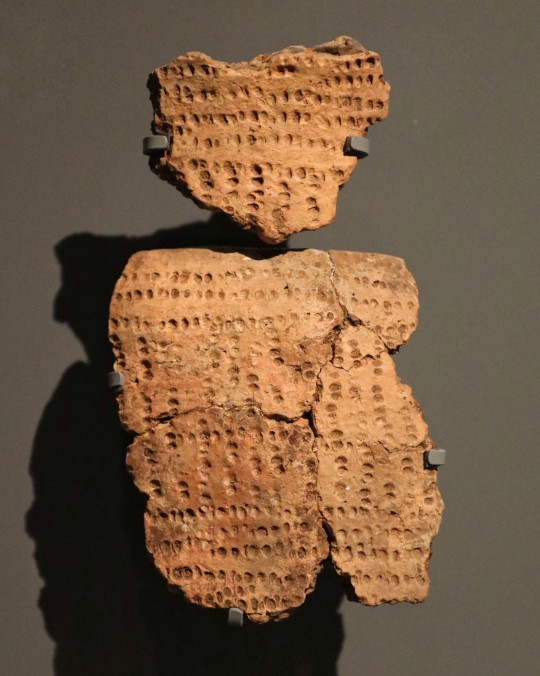
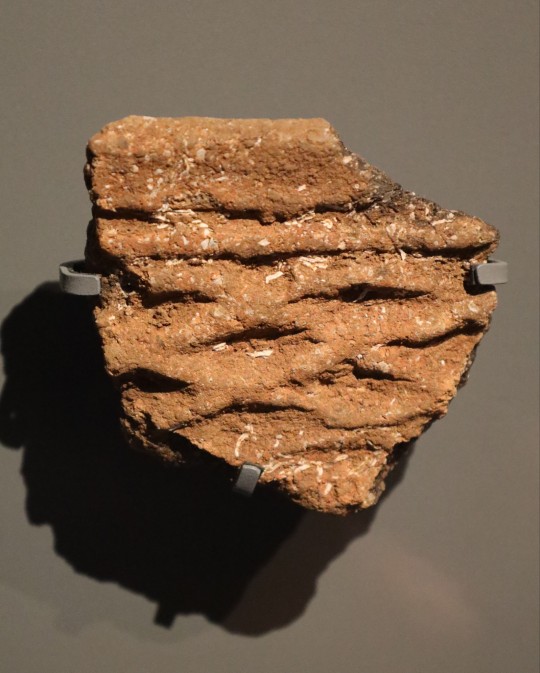
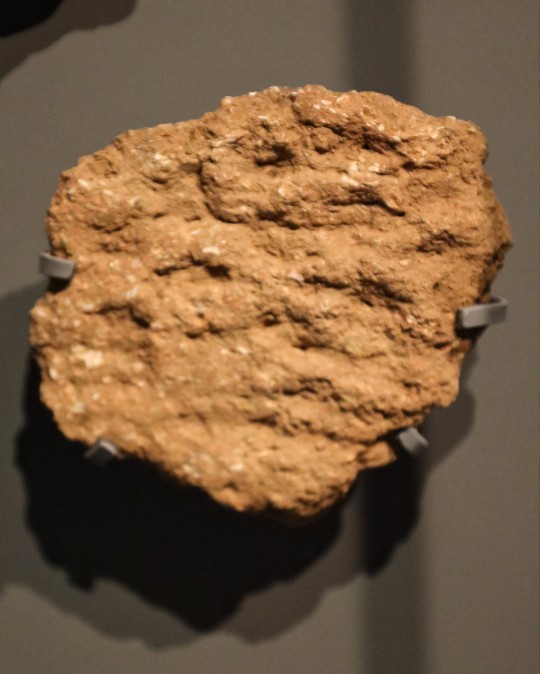
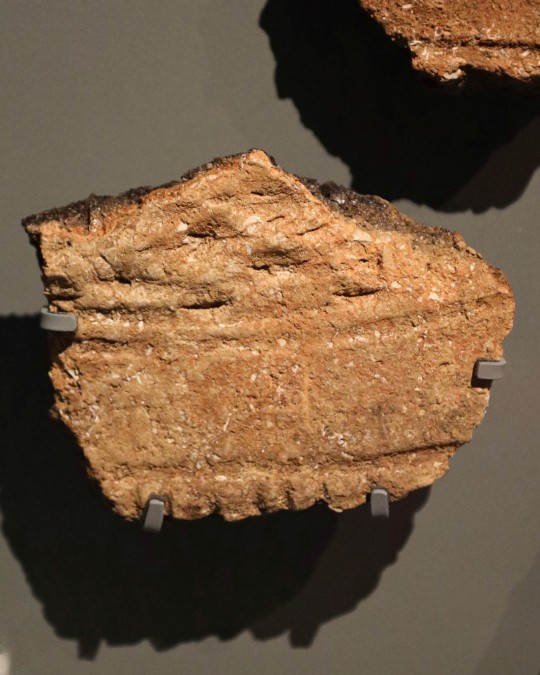
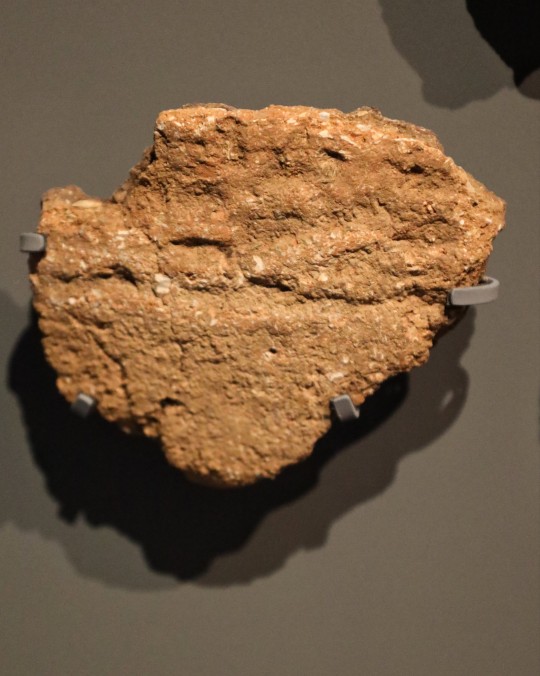
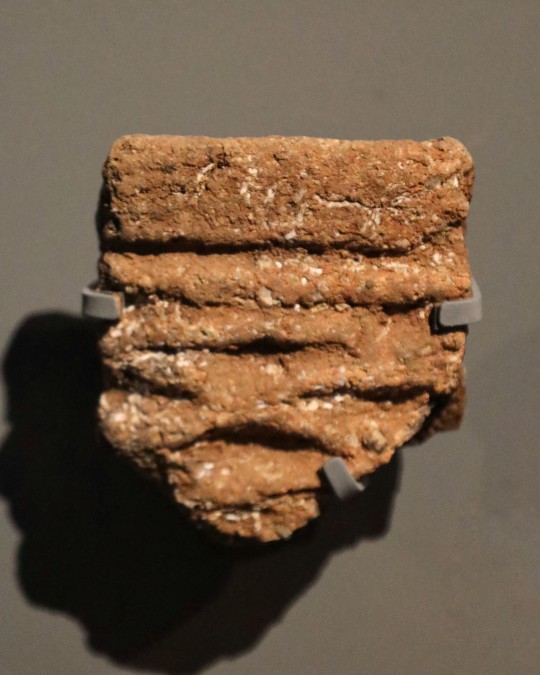

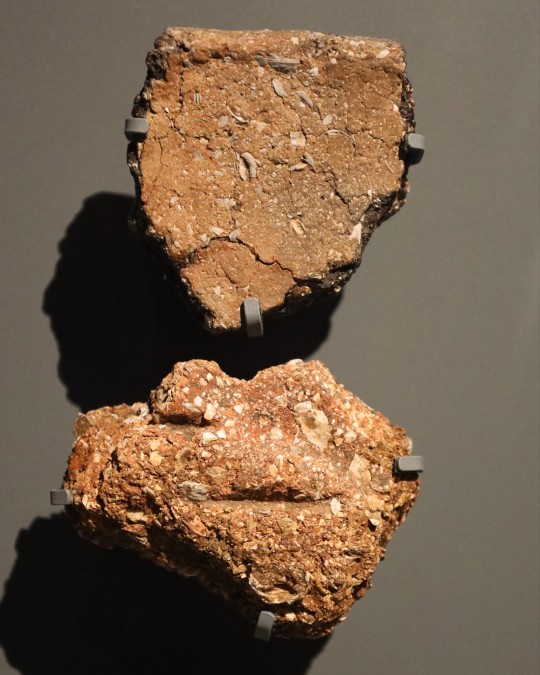
Prehistoric Pottery Fragments 1, Corinium Museum, Cirencester
#ice age#stone age#bronze age#copper age#iron age#neolithic#mesolithic#calcholithic#paleolithic#prehistoric#prehistory#prehistoric pottery#pottery#pottery fragments#beaker#urn#funerary pottery#archaeology#patterns#grooveware#relic#artefact#Cirencester
58 notes
·
View notes
Text

Ancient Egyptian hippo & hedgehog squad at the Brooklyn Museum!
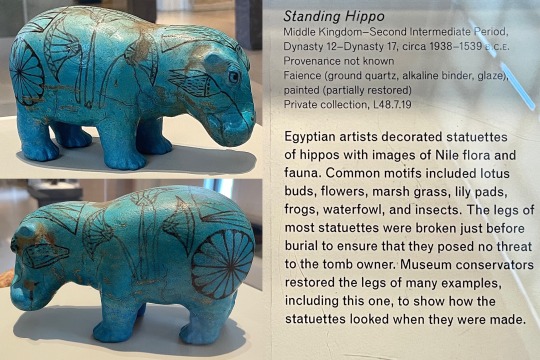
Standing Hippo
Middle Kingdom 2nd Int. Per. Dyn.12-17 c1938-1539BCE
Faience
“Egyptian artists decorated statuettes of hippos with images of Nile flora & fauna. Common motifs included lotus buds, flowers, marsh grass, lily pads, frogs, waterfowl, & insects. The legs of most statuettes were broken just before burial to ensure that they posed no threat to the tomb owner. Museum conservators restored the legs of many examples, including this one, to show how the statuettes looked when they were made.”
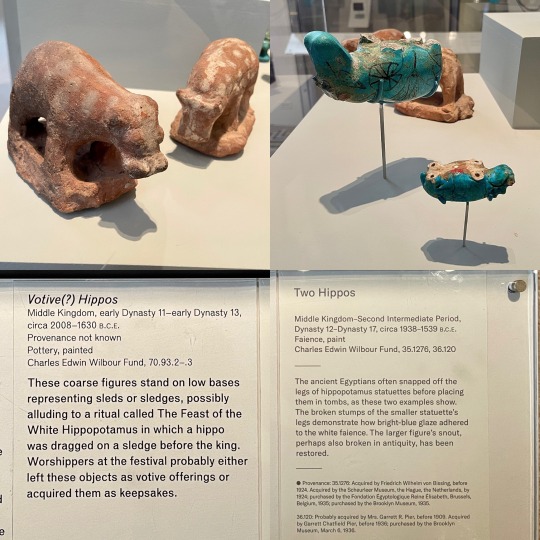
L: Votive(?) Hippos
Middle Kingdom Dyn.11-13 c2008-1630BCE
Painted pottery
“These coarse figures stand on low bases representing sleds or sledges, possibly alluding to a ritual called The Feast of the White Hippo in which a hippo was dragged on a sledge before the king. Worshippers at the festival probably either left these objects as votive offerings or acquired them as keepsakes.”
R: Two Hippos
Middle Kingdom Dyn.12-17 c1938-1539BCE
“The ancient Egyptians often snapped off the legs of hippopotamus statuettes before placing them in tombs, as these two examples show. The broken stumps of the smaller statuette's legs demonstrate how bright-blue glaze adhered to the white faience. The larger figure's snout, perhaps also broken in antiquity, has been restored.”
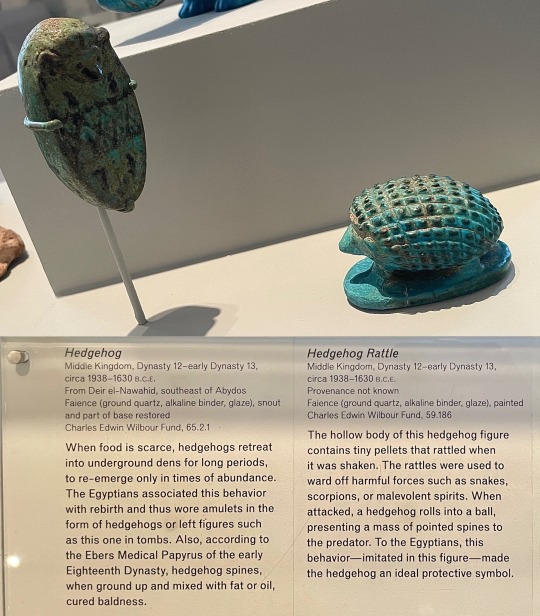
L. Hedgehog Rattle
Middle Kingdom Dyn. 12-13 c1938-1630BCE
Faience, 7.6 x 4.4 x 3.5 cm
“The hollow body of this hedgehog figure contains tiny pellets that rattled when it was shaken. The rattles were used to ward off harmful forces such as snakes, scorpions, or malevolent spirits. When attacked, a hedgehog rolls into a ball, presenting a mass of pointed spines to the predator. To the Egyptians, this behavior-_imitated in this figure-made the hedgehog an ideal protective symbol.”
R. Hedgehog Figurine
Middle Kingdom Dyn. 12-13 c1938-1630BCE
Faience, 4.2 x 4.1 x 7.1 cm
“When food is scarce, hedgehogs retreat into underground dens for long periods, to re-emerge only in times of abundance.
The Egyptians associated this behavior with rebirth and thus wore amulets in the form of hedgehogs or left figures such as this one in tombs. Also, according to the Ebers Medical Papyrus of the early Eighteenth Dynasty, hedgehog spines, when ground up and mixed with fat or oil, cured baldness.”
(note: labels are reversed - rattle is on L & figurine on R)
#animals in art#ancient art#Egyptian art#Ancient Egyptian art#Ancient Egypt#Brooklyn Museum#museum visit#hippo#hippos#hippopotamus#hippopotamuses#hedgehog#hedgehogs#pair#ceramics#pottery#faience#funerary art#votive#figurine#rattle
117 notes
·
View notes
Text

Today's Flickr photo with the most hits: a funerary urn with grave goods: now in the Kerameikos Museum, Athens. It is from this neighbourhood of Athens, just outside of the Diplyon Gate, that we derive the word 'ceramic' (it was the area where the potters obtained their clay).
16 notes
·
View notes
Text
at a pottery painting cafe w the bestie she is painting a pink frog i am painting. my best attempt at a design from a white ground funerary lekythos. on a mug
804 notes
·
View notes
Text

Wooden ushabti of king Tutankhamun with round ebony or nubian wig and golden collar.
The ushabtis, or funerary figures were intended to perform work in the place of the deceased in the afterlife. They were usually made of faience, wood, or pottery and were various sizes.
New Kingdom, 18th Dynasty, reign of Tutankhamun, ca. 1332-1323 BC. JE 60835; GEM 39126
Read more
211 notes
·
View notes
Text
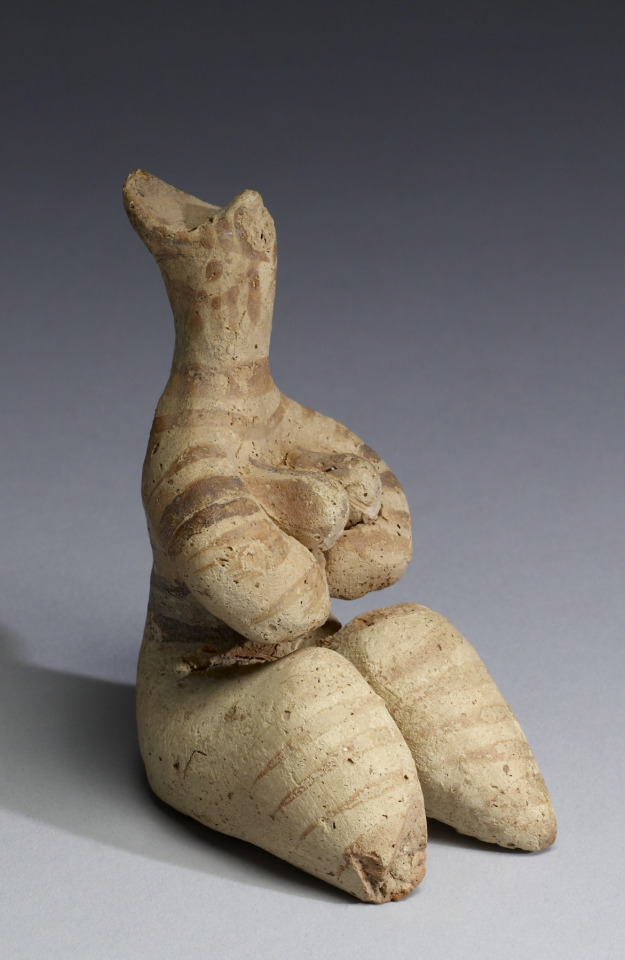
Tell Halaf Figurine
Syrian, 6th millennium BCE (Chalcolithic)
As early as the 7th millennium BCE, cultures in the Near East began to create organized settlements with well-developed religious and funerary practices. The Halaf culture of Anatolia (southern Turkey) and northern Mesopotamia is named for Tell Halaf in modern day Syria and is one example of such sophisticated early cultures. The Halaf culture flourished during the 6th millennium BCE and was notable for its ceramic productions, both its intricately painted pottery and remarkable female figurines.
79 notes
·
View notes
Text
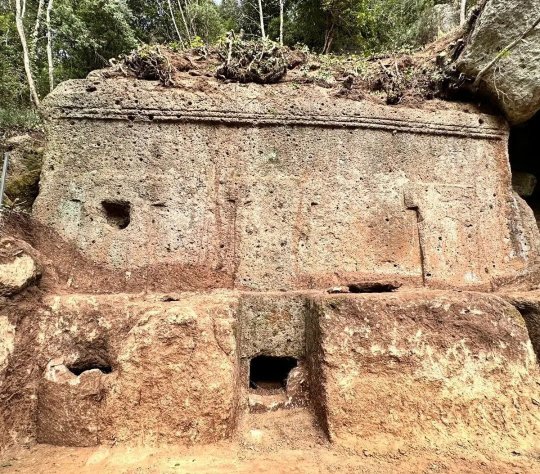
Three-Room Ancient Etruscan Tomb Discovered in Italy
A new three-room Etruscan tomb has been unearthed in the municipality of Barbarano Romano, which would have been right in the heart of southern Etruria, Italy, amid ongoing excavations in and around the municipality which have already revealed another significant tomb, and Etruscan artefacts.
The Etruscan necropolis of San Giuliano is carved into the rocks on the Marturanum Park, a protected conservation area in the municipality of Barbarano Romano, on the road connecting Rome and Viterbo. It has recently offered up yet another archaeological surprise, in the form of a partially-hidden, three-room tomb attached to the already-excavated Queen’s Tomb.

The ‘Tomb of the Queen’ (Tomba della Regina), a three-sided structure carved into the rock, dating from the 5th century BC and thought to be one of the most significant tombs in the necropolis, was selected to undergo restoration work this season.
During some clearing and cleaning work being carried out around the Queen’s Tomb, archaeologists in Italy noticed what appeared to be a second, partially-buried monumental Etruscan tomb, and after clearing the vegetation around it, found the structure in full.
Subsequent excavations uncovered the perfectly-preserved, three-chambered tomb, adjacent to three semi-flint doors, underneath the Queen’s Tomb. Experts suggest it was constructed in the 5th or 4th century BC, not long after the nearby Queen’s Tomb.

The burial chamber is also a testament to the advanced building techniques of the Etruscan culture, who were evidently able to excavate funerary structures in cliffs and rock faces.
Conservation and adaptation work on the newly-discovered tomb is set to be completed in the following months.
The Etruscan necropolis of San Giuliano, Italy, presents the greatest variety and richness of burial processes of any known Etruscan tomb, according to archaeologists. It presents a variety of artefacts and burial chambers thought to date right through from the 7th century BC to the 3rd century BC.

An Earlier Etruscan Tomb Discovered in Italy
In April last year another Etruscan tomb was discovered and excavated in the Necropolis of the Osteria, in Vulci, within the municipality of Montalto di Castro, Italy. The tomb was sealed, and inside there were numerous ceramics found, including a collection of pottery, amphorae, utensils, cups, and a bronze cauldron. The artefacts were all found in good condition, including a table cloth that was used in the Etruscan religious ritual of the ‘last meal’, a food offering burned inside the tomb before it was sealed.
This excavation was carried out by the Soprintendenza Archeologia, Belle Arti e Paesaggio for the province of Viterbo and southern Etruria.
By Matthew Norman.
#Three-Room Ancient Etruscan Tomb Discovered in Italy#Barbarano Romano#Tomb of the Queen#ancient tomb#ancient grave#ancient artifacts#archeology#archeolgst#history#history news#ancient history#ancient culture#ancient civilizations
58 notes
·
View notes
Text

A painted pottery vase in the form of a kneeling woman, holding a child about to nurse in her lap. It dates to the 18th Dynasty (circa 1550-1295 BCE).
The small size of the piece (only 12.7 centimeters in height) and its narrow mouth suggest that it was meant to contain some precious, perishable substance such as a cosmetic or medicine.
The subject of this work, so evocative of the goddess Isis and her divine son Horus, may have held a reassuring message in any of a number of contexts, funerary or otherwise.
This delightful piece (FGA-ARCH-EG-0634) is now in the Fondation Gandur pour l'Art, Geneva, Switzerland.
Photo (edited for size): Grégory Maillot / © Fondation Gandur pour l'Art, Genève.
Credit: Thoughts of Ancient Egypt
#art#history#design#style#archeology#sculpture#figure#vase#pottery#child#women#egypt#18th dynasty#isis#godess#horus
28 notes
·
View notes
Text
What should you do if you find an artifact (arrowhead, pottery shard, etc.), on US public lands?
This is a departure for me, but I recently saw a post here that suggested that if you found an artifact from the 1800s on federal land, you should take it to a museum.
PLEASE DON'T DO THIS!
If you find an artifact on public land, like a national park, please don't move it! Report its exact location to the agency that manages the land, like for a National Park, find the nearest park ranger.
Why?
Any time an artifact is moved, or removed, from its location, valuable information about that object is lost. Even if the object is returned, the context is destroyed.
Also, this is illegal, and most museums cannot accept artifacts collected illegally, i.e. on public land without a permit.
How do you know?
I studied anthropology & archeology in college, and then museum studies in grad school, so I'm fairly familiar with the major issues and US laws in question.
From the 1906 Antiquities Act which, among other things, first established penalties for removing objects from public lands, to the Native American Graves Protection & Repatriation Act, passed in 1990, which deals with the "repatriation and disposition of certain Native American human remains, funerary objects, sacred objects, and objects of cultural patrimony," US laws have increasingly provided care for natural and cultural objects found on federal land. (Laws concerning natural objects is a whole other subject, and mostly depends on which agency controls the land.)
This is a good thing! So, first of all:
What is an artifact?
Generally speaking, artifacts are things that people in the past made, purchased, collected, or left behind at archeological sites. Sometimes they're objects like arrowheads, but they can be more subtle traces of humanity, like bricks or wood from an ancient house. They might only be a few decades old, or they might be thousands of years old. (In other parts of the world, they may be hundreds of thousands of years old or older!)
What should you do if you find an artifact on public land in the US, including national parks, forests, BLM land, state parks, etc.?
Leave the artifact where you found it. Please don't pick it up, move it, throw it, put it in your pocket or your bag, or bury it.
Note & record your exact location. Snap a picture of the artifact where you found it. Step back and photograph the artifact with a landmark. Please don't post them on social media. (If you take a photo with a recent cell phone, it will automatically record the GPS coordinates if you have location services turned on. This information can be extracted from the original photo file.)
Report what you found. Show a park ranger your pictures and the location of the artifact. If you cannot find a ranger, or you're not on park service land, you can email your photos and findings to the Archeology or Cultural Resources division of the land's governing body. If you're not sure where to turn, I'd email your State Archeologist (Google your state + "office of state archeology") and ask for help.
The agency in charge will appoint an archeologist to properly investigate the site, conduct any necessary fieldwork, and recover and curate the artifacts (or convey them to a museum or other approved repository). Artifacts generally then become available to researchers for study, and sometimes for display in public exhibits.
More about what archeologists do
#archeology#ancient artifacts#cultural artifacts#national parks#national monuments#national forests#BLM lands#US laws#united states#I'm not very familiar with laws in other countries#but I know many have similar laws#museums#thanks for coming to my TED talk#history museums#natural history museums
11 notes
·
View notes
Text
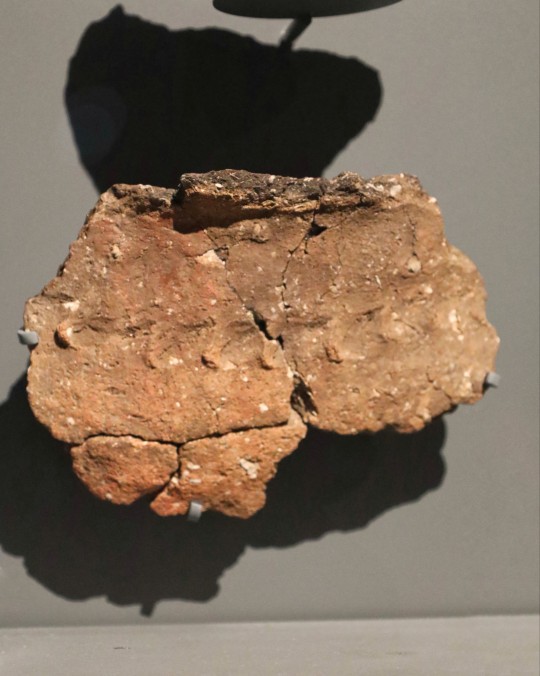
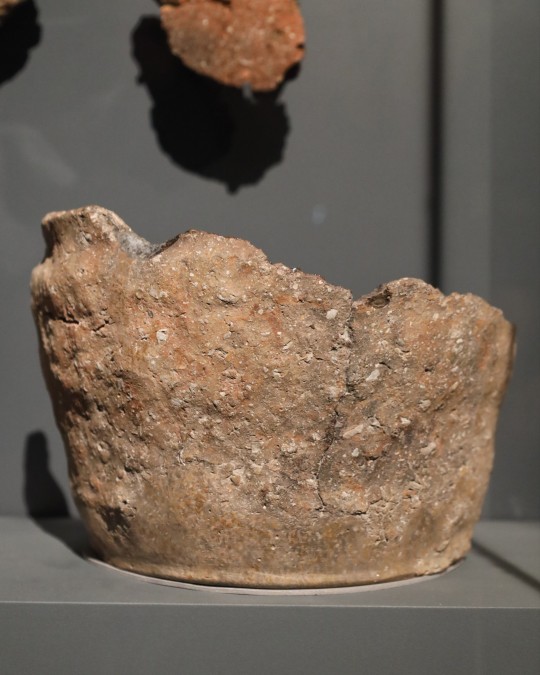
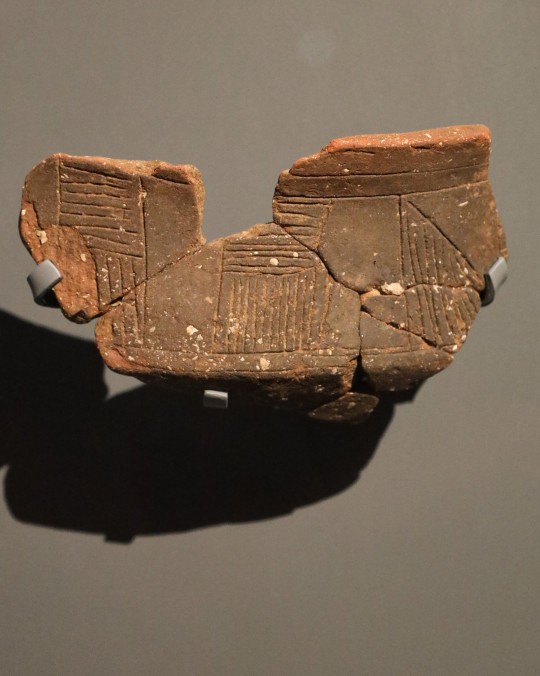



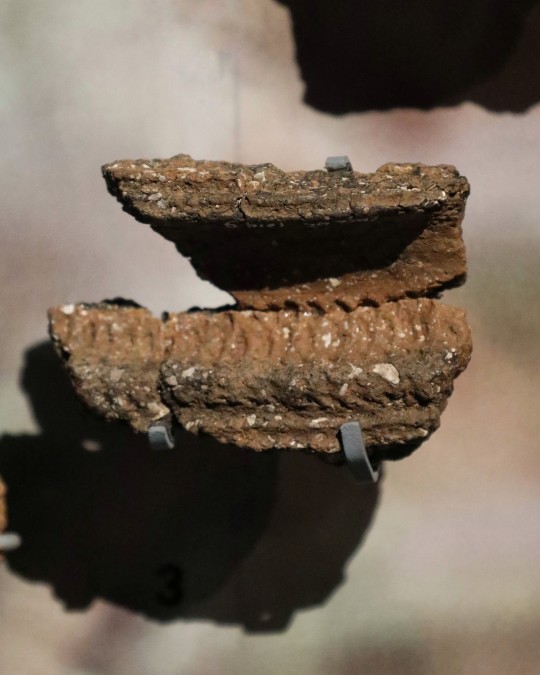

Prehistoric Pottery Fragments 2, Corinium Museum, Cirencester
#ice age#stone age#bronze age#copper age#iron age#neolithic#mesolithic#calcholithic#paleolithic#prehistoric#prehistory#grooveware#pinchpot#funerary pottery#pottery fragments#prehistoric pottery#beaker#burial mound#Cirencester
25 notes
·
View notes
Text

“Jar with figural decoration
From Karanog, grave 566
Meroitic Period (C. 100 B.C.E.-300 C.E.)
Ceramic and paint, h. 34 cm (13 3/8 in.)
Coxe Expedition, 1908 E818
From a grave in the large Meroitic cemetery at Karanog, this vividly painted jar was part of a set of funerary goods belonging to one of the elite members of Meroitic society. A frieze of foraging giraffes is painted in the midsection and one of undulating snakes around the upper body. Pottery was mass-produced in Nubia by Meroitic times, but its often vibrant and original decoration shows that ceramics were an important avenue of artistic expres-sion. Meroitic pottery contrasts markedly with the drab, utilitarian pottery used in Egypt during the same period.
The Meroites decorated their pottery with an inventive blend of uniquely Nubian, Egyptian, and Greco-Roman themes. This example is one of a number of jars from the Karanog cemetery with a giraffe motif. During Meroitic times, giraffes were not found in the arid environs of Lower Nubia but much farther south, in the savanna lands of southernmost Nubia. The clumsy appearance of the animals on the Meroitic jars suggests that the artists had never seen a living giraffe.
- JWW”
14 notes
·
View notes
Photo
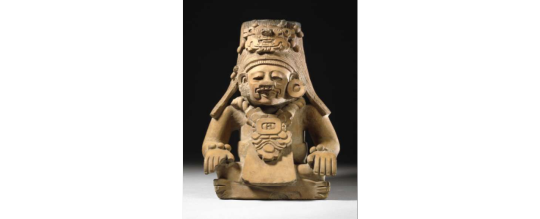
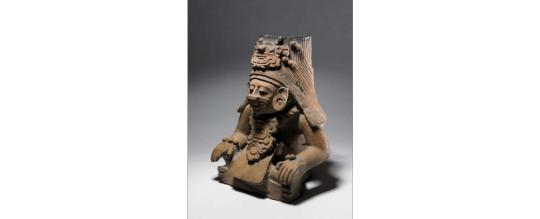
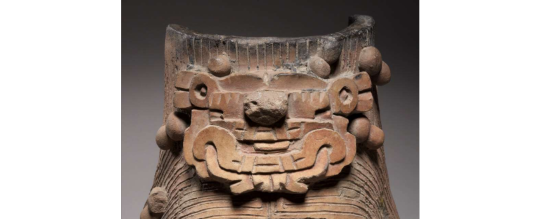
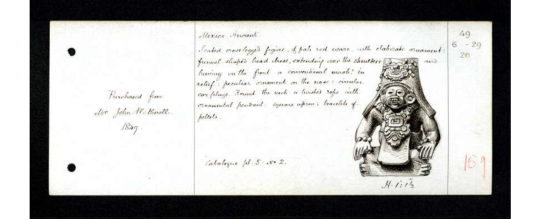
vessel; figure; funerary urn
Cultures/periods: Zapotec
Production date: 200 BC - AD 800
Findspot: Oaxaca
Provenience unknown, possibly looted
Pottery offering vessel or funerary urn in the form of a human figure, probably an ancestor, seated cross-legged; funnel-shaped headdress extending over the shoulders; nose ornament; circular earplugs; round the neck a twisted rope with ornamental pendant.
McEwan 2009
Funerary urns representing revered ancestors were buried with deceased rulers in tombs surrounding the central plaza of the Zapotec capital, Monte Alban. The seated figures wear masks and headdresses embodying supernatural forces and beings such as the storm or thunder gods. Some are identified by year signs and name glyphs taken from the 260-day ritual calendar that are displayed on the chest ornament. The tombs were visited repeatedly over many generations as the focus for royal ancestor worship. Offerings of burning incense, fresh blood, chocolate and fermented "pulque" were made to entreat the ancestors to intercede favourably in human affairs.
British Museum
41 notes
·
View notes
Text

Ancient Roman Elite Necropolis Discovered in Italy
A two-year dig to install a solar power plant near Rome has unearthed an ancient Roman necropolis containing 67 skeletons buried in 57 ornate tombs.
Archaeologists were baffled by the find — thought to date between the second and fourth centuries — not least because the skeletons were discovered wearing golden jewelry and expensive leather footwear, inside tombs designed to resemble their homes.
The discovery, on a 52-acre patch of land close to the ancient city of Tarquinia, north of Rome, was a surprise to authorities, despite the area being renowned for such findings.
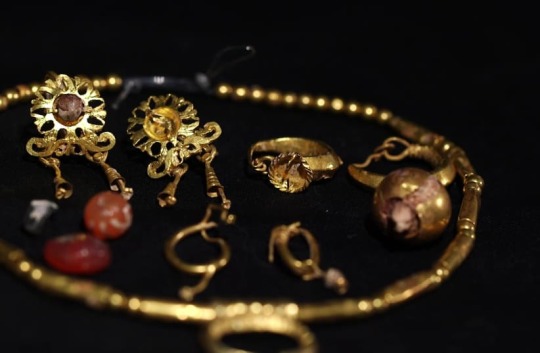
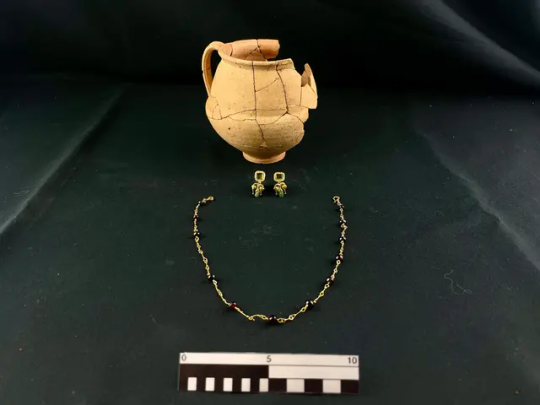
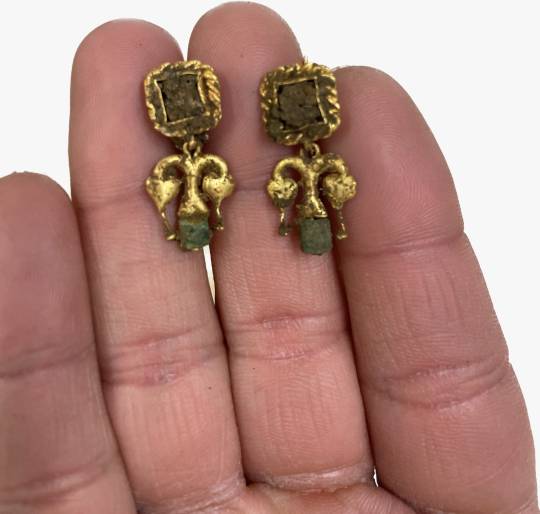
Silver rings with amber and engraved initials, precious stones, terracotta pottery, coins, shiny glasses, amulets and even items of clothing were found alongside the golden necklaces and earrings.
“We found several skeletons still wearing their expensive stockings and shoes,” Emanuele Giannini, lead excavation archaeologist at the site said. “All these riches, and the fact that the bones show no sign of stress or physical labor, (leads us to believe) these weren’t local farmers, but upper-crust members of Roman families coming from cities.”
Giannini said techniques of “pre-emptive archaeology” such as field surveys and trial trenches were used to identify potentially ancient constructions below ground.
“We did have a faint idea that some treasure could lie there, as historical sources mentioned the location of a postal station for travelers near the site,” explained Giannini. “Many Romans would stop (here) for the night to eat and rest, but the magnitude of the discovery is unmatched.”


The diversity of funerary objects laid near the remains, and the luxurious designs and linings inside the tombs, have led archaeologists to believe that the occupants wanted to recreate heavenly spaces similar to their earthly homes. The interior of many tombs originally featured elaborate cloth linings, or were surrounded and covered by tiles or terracotta pieces like little houses.
Giannini said another astounding aspect is that most of the discovered tombs were communal — built for at least two occupants who likely shared a family link. A few skeletons were found wrapped around each other.
“Building tombs for entire family nuclei is a typical ancient Roman trait,” he said, “but these are outstanding in their inner decor, which shows wealth and status.”
The shallow tombs were found just 20 inches below the surface — almost popping out of the grass — yet nobody had ever noticed anything peculiar.
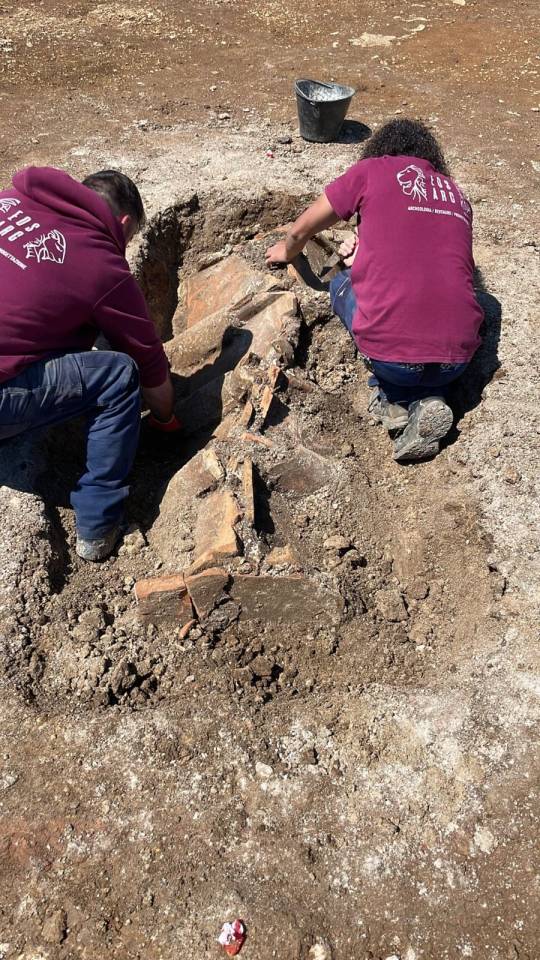



The site’s unique state of preservation has been attributed to the fact that “huge limestone blocks that stick out of the ground (made) ploughing, seeding and modern farming impossible in the area,” said Giannini. “It has remained untouched (for) centuries.”
Findings from the dig, which started in 2022, are being preserved as they’re found and many are going on show at the castle of Santa Severa in the coastal town of Santa Marinella. The skeletons however, are being analyzed to determine their origins and will not be put on display until forensic tests have been carried out.
Whatever their genesis, authorities are certain more hidden wonders will come to light as digs for the solar park move to another nearby site.
“We are excavating a huge rural area to redevelop the land and are balancing the need to avoid ruining such unique wonders with the goal of boosting clean energy production,” Margherita Eichberg, art heritage superintendent of the provinces of Viterbo and southern Etruria for Italy’s Culture Ministry said. The area where the necropolis has been discovered will not form part of the solar park and will be cordoned off for safety reasons, without public access.
“This is the fascination and beauty of Italy: Each time there’s a dig, incredible wonders from the past come out of the ground which need to be preserved.”
By Silvia Marchetti.

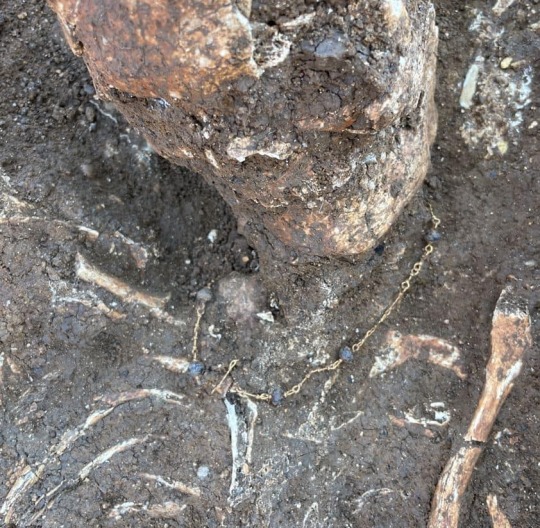
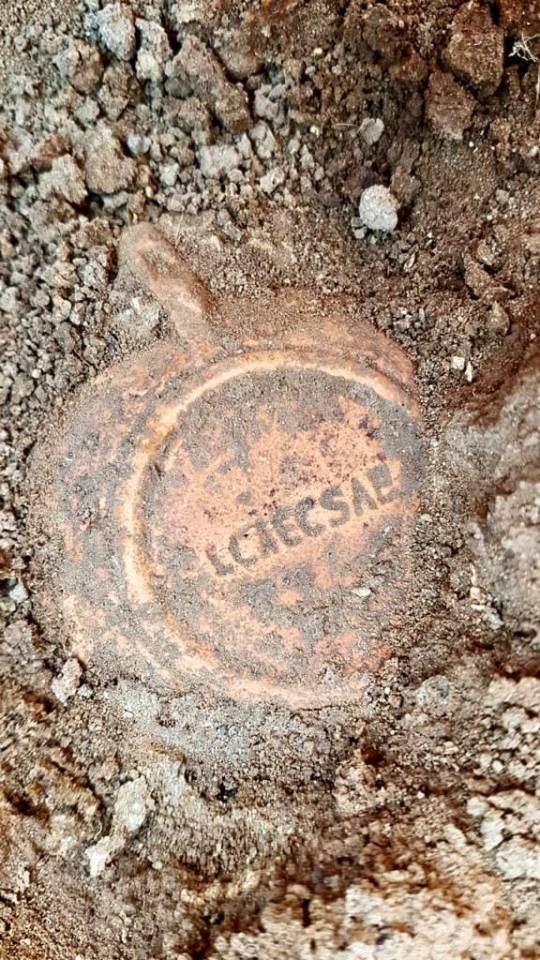


#Ancient Roman Elite Necropolis Discovered in Italy#ancient city of Tarquinia#ancient graves#ancient tombs#funeral goods#gold#silver#ancient artifacts#archeology#archeolgst#history#history news#ancient history#ancient culture#ancient civilizations#roman history#roman empire#roman art
72 notes
·
View notes
Text
Some breathtaking sculptures throughout the time
Venus of Willendorf (25,000 BP)
It has been suggested that she is a fertility figure, a good-luck totem, a mother goddess symbol, or an aphrodisiac made by men for the appreciation of women. It is an 11.1-centimetre-tall (4.4 in) Venus figurine estimated to have been made around 25,000-30,000 years ago.

Nefertiti Bust (1345 BCE)
The Nefertiti Bust is a painted stucco-coated limestone bust of Nefertiti, the Great Royal Wife of Egyptian pharaoh Akhenaten. It symbolizes both the power of the sun and the strength of royalty in ancient Egyptian culture.

The Terracota Army (210–209 BCE)
The discovery of the Terracotta Army is important because of the information it gives historians about daily life in the Chinese Qin dynasty. The figures show armour and weapons, and the tomb contains many real artefacts such as chariots, weapons, pottery, and the human remains of workers who built it. It is a form of funerary art buried with the emperor.

Laocoön and His Sons (323 BCE – 31 CE)
In true Hellenistic fashion, Laocoön and His Sons showcases an interest in the realistic depiction of movement. In the action-packed scene, three figures frantically try to free themselves from the grasp of sinuous serpents.
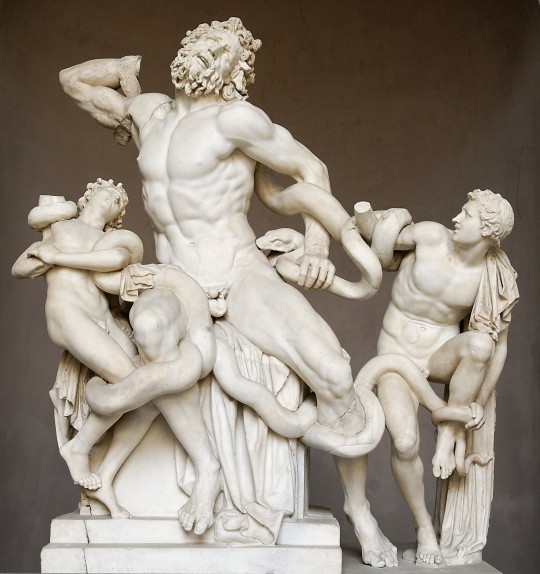
David of Michelangelo (1501– c. June 8, 1504)
During the High Renaissance, Michelangelo created figurative works that focused on balance, harmony, and the ideal form. David showcases these artistic sensibilities through his lifelike, asymmetrical posture—known as contrapposto or “counterpose”—and his realistic and highly detailed anatomy.

The Ecstasy of St. Teresa (1647–1652)
It depicts a scene from the saint's spiritual autobiography. Teresa recalls an angel wielding a fire-tipped spear who repeatedly pierces her heart, causing her to experience spiritual bliss.

Perseus with the Head of Medusa (1800 and 1801)
Perseus has decapitated Medusa because the gaze of Medusa turned all who looked at her to stone. Perseus guided himself by her reflection in a shield given him by Athena and beheaded Medusa as she slept. He then returned to Seriphus and rescued his mother by turning Polydectes and his supporters to stone at the sight of Medusa's head. The said sculpture is a depiction of that.

All the pictures are collected from Pinterest and briefings have been extracted from various articles through google.
#sculpture#michelangelo#david#artistic#art#medusa#mythology#perseus#teresa#renaissance#terracota#soldiers#china#venus#nefertiti#ancient egypt
12 notes
·
View notes
Text
Archaeologists have uncovered Greek full-colour portraits of mummies – the first to be found in 115 years – the Egyptian government has announced.
Researchers found the two full portraits of Egyptian mummies and fragments of others at the Gerza excavation site in Fayoum, making these artworks the first of their kind to be discovered in over 115 years.
English archaeologist Flinders Petrie was the last to find similar artwork when he discovered 146 mummy portraits at a Roman cemetery in 1911, Artnet News reports.
The findings are from a dig site located amid the ruins of the ancient city of Philadelphia, which according to the Austrian Archeological Institute, lies in the northeastern corner of Fayoum, approximately 75 miles southwest of modern-day Cairo.
The team investigating the Gerza archaeological site in Fayoum also uncovered a funerary building, records written on papyrus, pottery, and coffins dating from the Ptolemaic period, which spans from 305 B.C. to 30 B.C., through the Roman era, which lasted from 30 B.C. to 390 A.D.
The government has said these finds give fascinating insights into the social, economic, and religious conditions of the people living in Philadelphia (which meant, in ancient Greek, "City of Brotherly Love") nearly 2000 years ago.
The collection of paintings, known as the Fayoum portraits, portrays some of the wealthiest people that existed in these ancient communities. The Philadelphia settlement was home to Greeks and Egyptians over the 600-year period.
Basem Gehad, the head of the Ancient Philadelphia Excavation project, which led the latest dig, wrote in an email to Artnet News that "no one really knows the context of these portraits," but added, "Now, we can know certainly where they came from, and find more."
In addition to these finds, archaeologists also revealed a rare terracotta statue of the goddess Isis Aphrodite inside a wooden coffin, per Artnet.
Gehad told the news outlet the statue "reflects the influence of Greeks on Egyptian art as a result of [the] new community living there."
A statement from the Egyptian government explains that pharaoh Ptolemy II Philadelphus (309–246 B.C.) established Philadelphia as an agricultural village meant to secure further food resources for his empire.
Researchers have been digging at the site since 2016, according to the government.
2 notes
·
View notes
Text
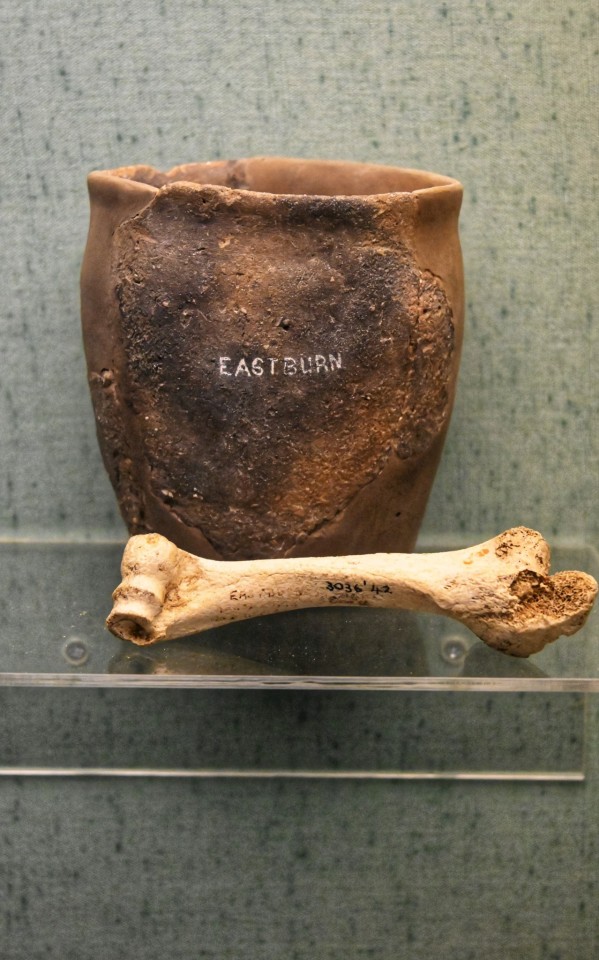
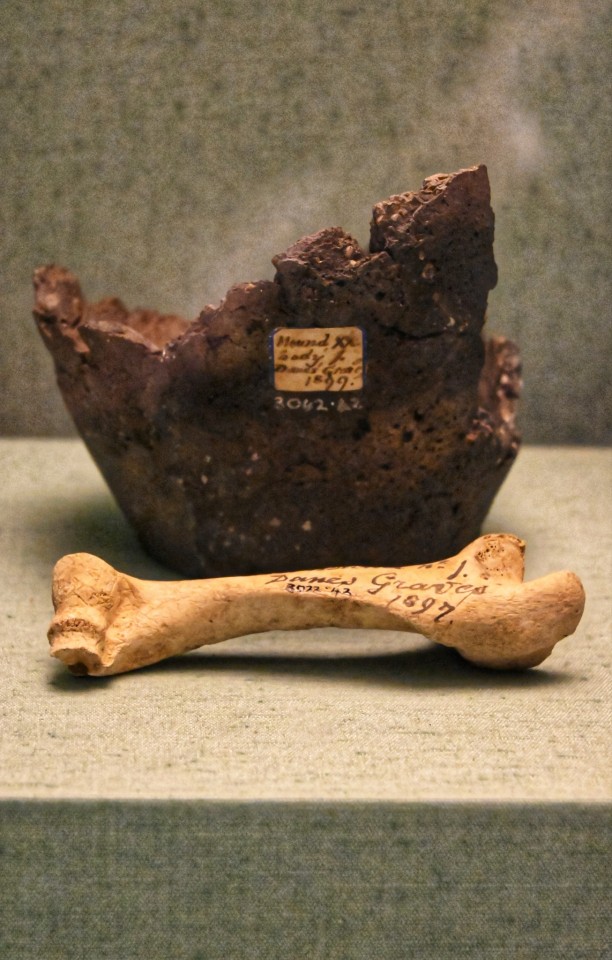

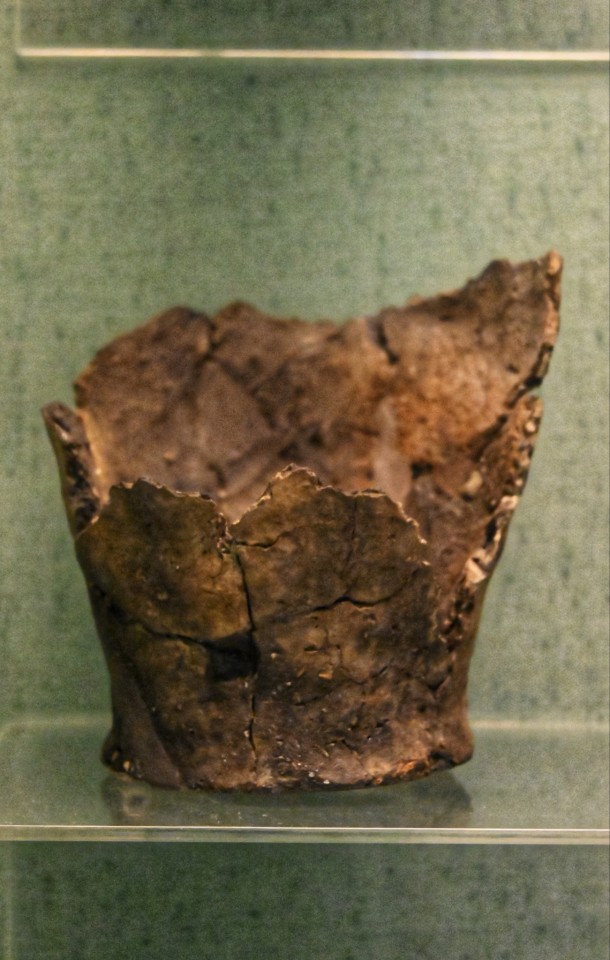


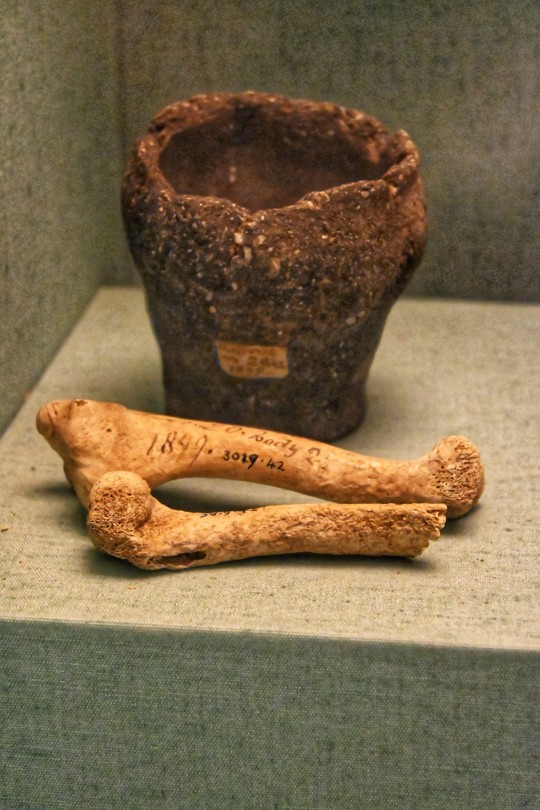

Iron Age Funerary Pots and Bone Grave Goods, Hull and East Riding Museum, Hull, Yorkshire
#ice age#stone age#bronze age#copper age#iron age#neolithic#mesolithic#calcholithic#paleolithic#prehistoric#prehistory#funerary pottery#ritual#pottery fragments#pottery#archaeology#relic#artefact#yorkshire
50 notes
·
View notes